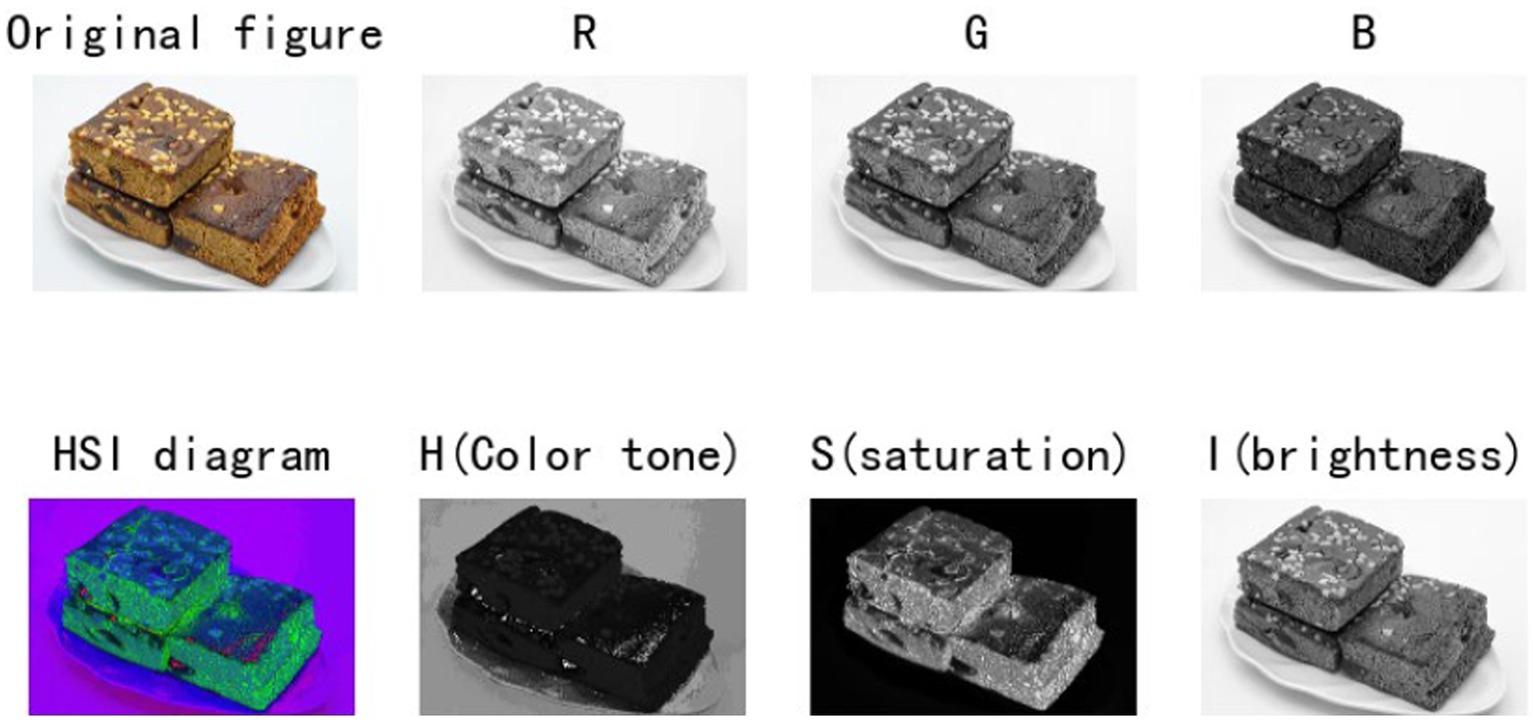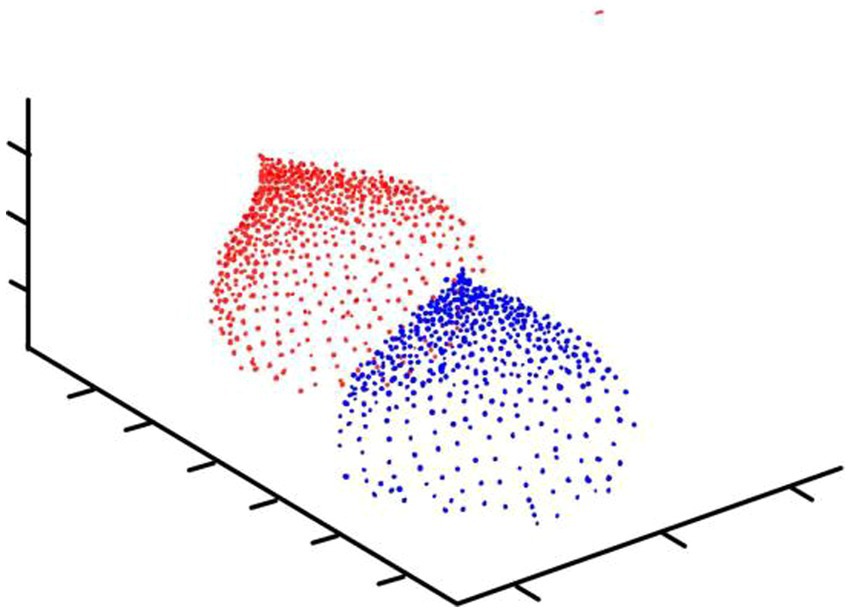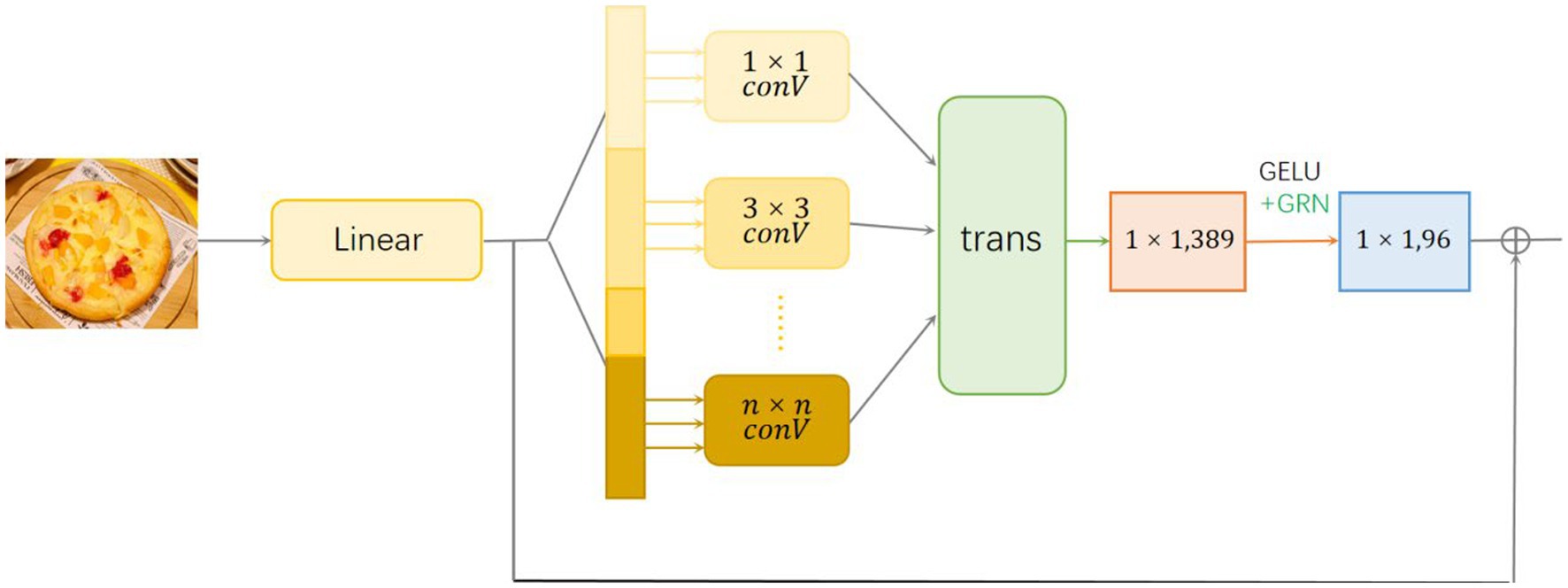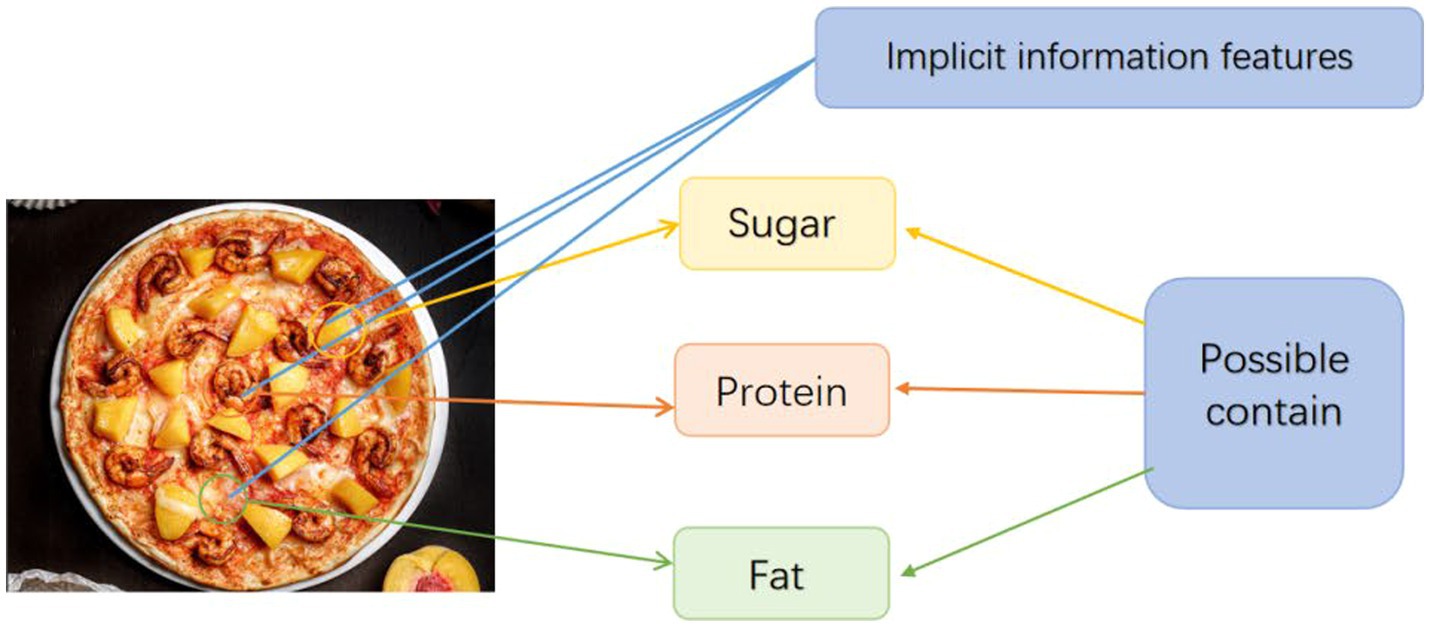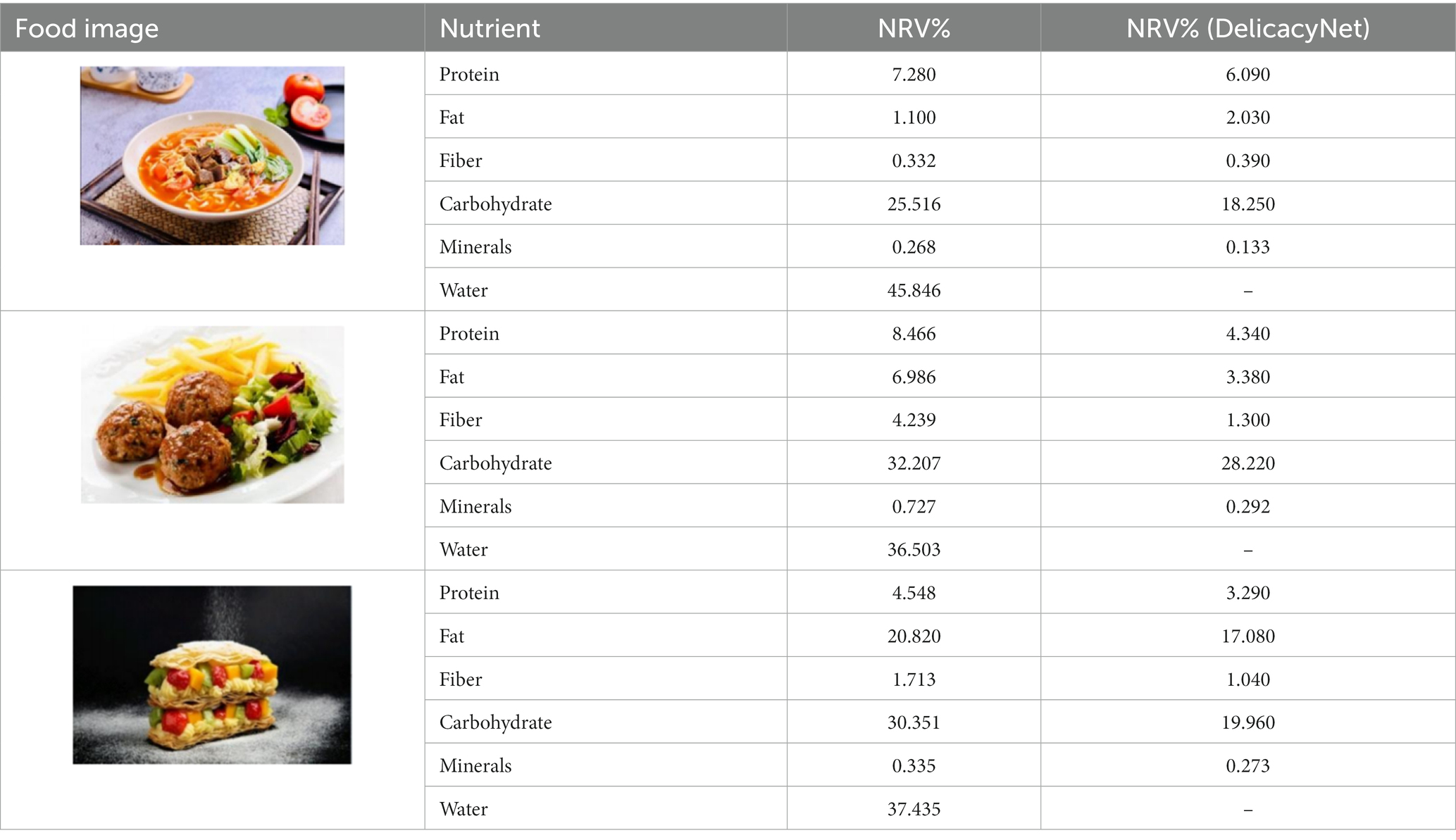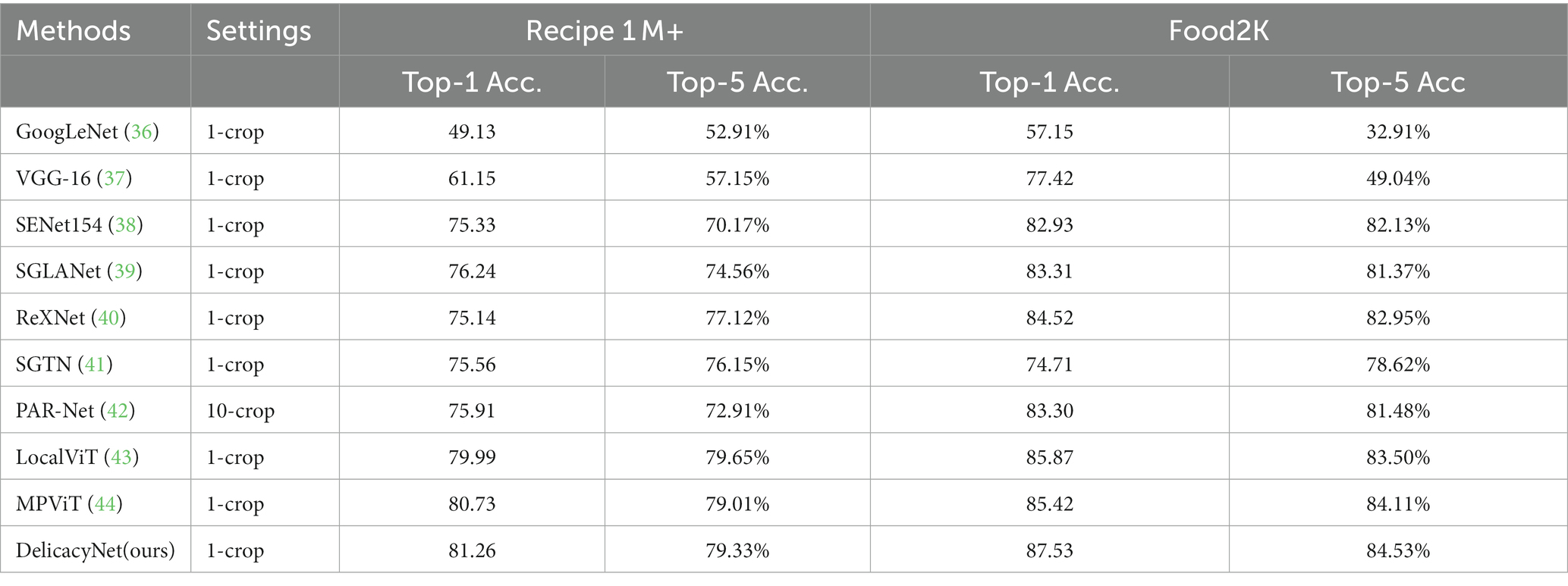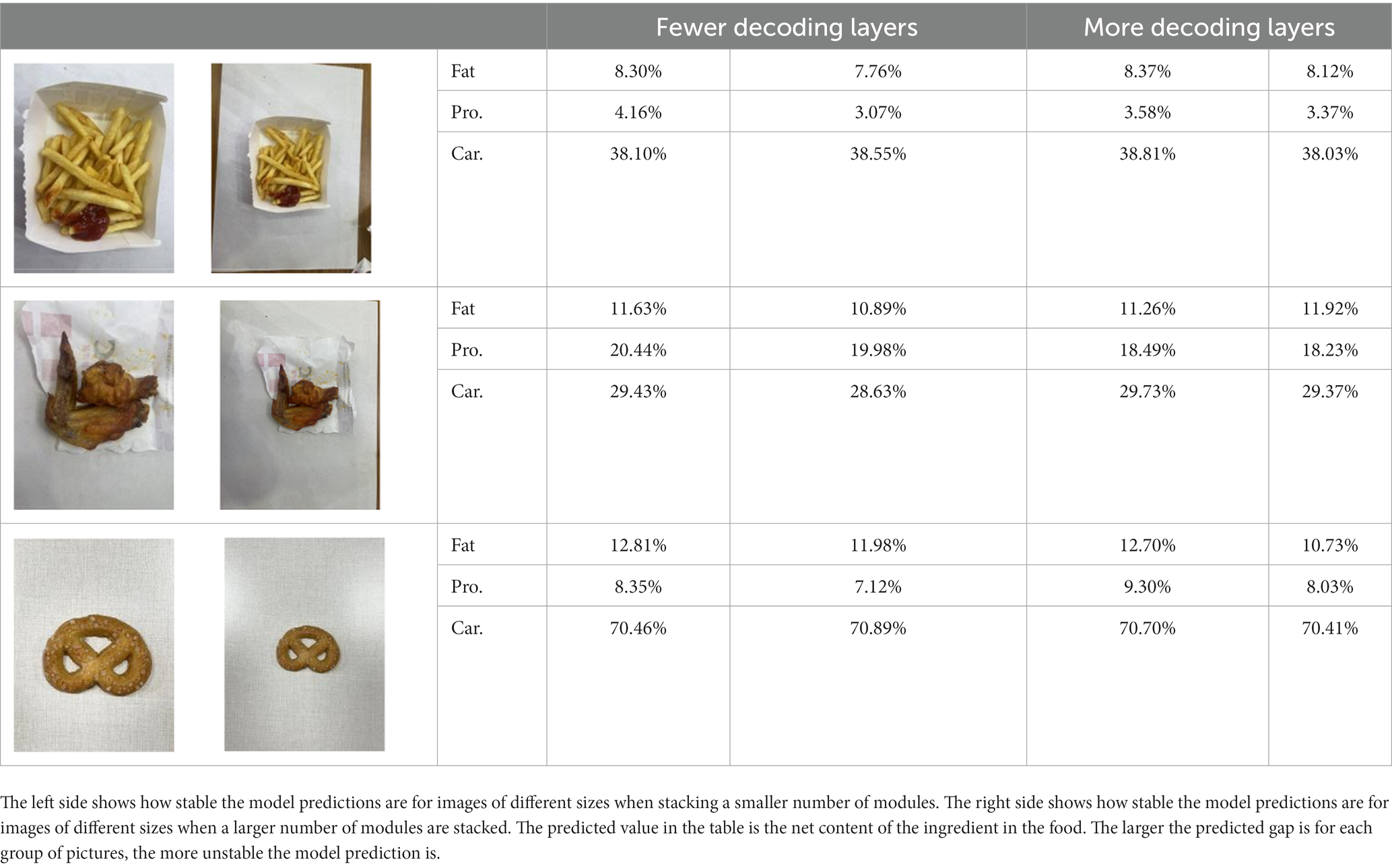- 1College of Computer Science and Technology, Faculty of Information Science and Engineering, Ocean University of China, Qingdao, Shandong, China
- 2Haide College, Ocean University of China, Qingdao, Shandong, China
- 3College of Food Science and Engineering, Ocean University of China, Qingdao, Shandong, China
In this paper, we are interested in how computers can be used to better serve us humans, such as helping humans control their nutrient intake, with higher level shortcuts. Specifically, the neural network model was used to help humans identify and analyze the content and proportion of nutrients in daily food intake, so as to help humans autonomously choose and reasonably match diets. In this study, we formed the program we wanted to obtain by establishing four modules, in which the imagination module sampled the environment, then relied on the encoder to extract the implicit features of the image, and finally relied on the decoder to obtain the required feature vector from the implicit features, and converted it into the battalion formation table information through the semantic output module. Finally, the model achieved extremely high accuracy on recipe1M+ and food2K datasets.
1. Introduction
Food is the priority of the people. The six nutrients contained in food not only constitute the body, but also produce energy to maintain human growth after metabolism (1, 2). Every day, billions of people share comments related to food on social networks (3), which shows that food has irreplaceable value in our life. There has been a shift in dietary guidelines around the world from focusing on single nutrients to focusing on food patterns, food groups and dietary components, which provides an opportunity for our research (4–6). Different cooking techniques and cooking time will produce different kinds of food. Even though there are obvious differences between Chinese and Western food cultures, the data of these images were included in our training database (Food2K, Recipe1M+, and USDA National Nutrient Database), covering all kinds of food to the greatest extent.
Food image recognition is a basic task of food computing (7). By introducing large-scale Food databases, such as Food2K dataset, Recipe1M+ dataset, and ETH Food-101, Vireo Food-172 (8) and ISIA Food-500 datasets (9), it becomes a branch of fine-grained visual recognition (10). Recipe1M+ is the largest publicly available recipe dataset, which includes 13 million food images and more than 1 million cooking recipes, providing an opportunity to design high-capacity models on unified multimodal data (11, 12). The Food2K dataset involves 12 superclasses (such as vegetables, meat, barbecue, and fried foods, etc.) and 26 subcategories, containing both Eastern and Western dishes, increasing the number of images in the dataset by orders of magnitude. This dataset covers a wide range of diverse visual appearances, and pays attention to the global and local features of images. Therefore, the deep progressive mode of food recognition should be adopted, and the richer global background was integrated into the local background features to improve the retrieval accuracy (13).
With the development of interactive technology integrated with various food environments, in the field of human-computer interaction (HCI), people continue to challenge digital food technology, in order to improve food living standards more efficiently (14, 15). In the early 2020s, Transformer was widely used as a deep learning model utilizing an attention mechanism to increase the training speed of the model for creating musical rhythms (16), occluded image recovery (17), mathematical operations, etc. (18, 19). In medical research, integrating neural distance and texture-aware transformers can help improve prognostic prediction of pancreatic cancer (20). Then Vision Transformers (ViTs) emerged and replaced ConvNets as the state-of-the-art image classification model. Among the many improvements to ViT, the Swin Transformer counts as a very successful one. Aiming at the problem that the CV task is generally multi-scale pictures and the image resolution is large, the local attention calculation module LSA is creatively proposed, that is, the self-attention is calculated only within the window. Compared with ViT, the performance is also greatly improved, which improves the practicability of Transformer. In 2020, FAIR introduced ConvNext, a pure convolutional neural network with non-vit performance, and in 2023, ConvNext-v2 (21, 22) combines MAE from NLP to achieve SOTA performance on fundamental vision tasks.
Deep learning has been widely used in various fields currently. The pseudo-siamese network can effectively correct underwater non-uniform illumination images, separating the non-uniform illumination layer from the ideally illuminated image (23), thus achieving the purpose of enhancing image details and improving image quality, and thus achieve the purpose of enhancing image details and improving image quality. A novel physically-aware two-stream underwater image enhancement network, PA-UIENet (24), reduces errors when facing various underwater scenes by simulating image degradation and learning features of various underwater scenes. The Complementary Learning with Content Noise in Pharmaceutical Images (CNCL) strategy leads in visual quality and quantitative metrics by leveraging features unique to medical images (25).
The training of such computer programs is affected by datasets and domain gaps, which is also a great challenge for us. What we created is a model consisting of Encoder and Decoder, by preprocessing the input image, and then using the autoattentional encoder to adjust the final output target. To achieve this, we designed an innovative neural network structure DelicacyNet, which employed innovative structures and components for efficient semantic processing of food images. For the training model we used Food2K, Recipe1M+, and USDA National Nutrient Database. The performance of the model was evaluated using a custom loss function to monitor the performance of the model during the training and validation phases.
In traditional image recognition, fine-grained image recognition captures local image features with the help of semantic models, but dishes in food images cannot be discriminated by defining local images (26). Moreover, it adds extra difficulty to our procedural work due to the different sizes of dishes in the received food images. In addition, a large number of ingredients may be mixed in the same food, each with a different nutrient composition, which adds to the difficulty of direct discriminatory analyzes. Food image recognition is uniquely composite and difficult to segment, which poses a great challenge to our final output of nutrient content percentage.
2. Methods
It is a challenging task to extract nutritional information of food only from images. Throughout the cooking process, food undergoes a variety of physical and chemical processing methods and is mixed with various flavors, which will affect the original size, shape and color of food ingredients to a certain extent (27–29). Meanwhile, due to the different cooking process and storage time of food ingredients, the final image of the same food ingredient will also lead to color deviation, which brings great challenges to the image recognition and annotation.
We believe that global information cognition and local feature analysis are equally important in this problem, so we decide to extract global information and local features at the same time. Supplementary Figure S1 shows the basic structure of our model. The whole model consists of four parts: environment feature extraction module (EFE), encoder, decoder and semantic output module. The input of the model is in the form of an image, and the output is in the form of a text representing the nutrients in the food and their content.
2.1. Environment feature extraction module
In the process of food image processing, a difficult problem is the influence of environmental information, because in practical applications, the image will contain a lot of environmental information, which will interfere with the subsequent judgment of semantic extraction module. In order to better adapt to the needs of food image processing, this paper proposes a lightweight environmental feature extraction module (EFE), which can preserve the core feature information of the image as much as possible under the condition of realizing environmental denoising.
2.1.1. HSI image conversion layer
In the study, we observe that the HSI image reconstructed by the formula has more information than the original RGB image (Figure 1), and it is also more conducive to the subsequent core feature extraction and background clutter removal. Therefore, at the beginning of the environment module, we added an HSI module to improve the performance of the model.
The image conversion formula is as follows:
2.1.2. Normalization layer MDN
MDN is a different kind of normalization layer from traditional thinking. It divides a number of intervals (or different distribution functions) based on the probability distribution of the information contained in the pixel (Figure 2). By dividing the interval, the visual subject of the image and the environment can be separated to further achieve good information extraction results.
Specifically, we take advantage of the huge difference between the background and the visual center information, layer according to the convolution results of the convolution layer, and preprocess the function for each layer. The final normalization results in dividing each number by the norm of the plane of normal distribution into which it is partitioned. In detailed, it is:
2.1.3. Environment feature extraction module
We choose the fully convolutional neural network as the backbone network of the module. After mapping the image to one dimension through linear layers, in order to enhance the local sensibility and global difference judgment ability of the model, we introduce multiple convolution layers with different convolution kernel sizes, so that it can capture spatial features at multiple scales. Here, different convolution kernels are used to convolute the linear layer, respectively. After the convolution, tensors of different sizes and different numbers will be obtained according to the size of the convolution kernel. After recombining the tensors using the transformation layer, the 1 × 1 convolution kernel is used for convolution, and finally the 1 × 1 convolution kernel is used again after normalization (Figure 3).
2.2. Encoder
Only using the environment feature extraction module has a good image processing effect, but there is no way to associate the image with the semantic. The role of the encoder is to parse out the semantic information from the image. For better information extraction, we used multi-layer transformer architecture combined with Atrous Spatial Pyramid Pooling (ASPP) module (30). The ASPP module was able to capture multi-scale image features. In order to obtain richer local information, a residual structure was used between the encoder and the original image (31). The input of the encoder was the output feature tensor of the EFE module, and the output was the processed feature tensor (32).
The transformer module was refined into the following submodules:
Linear projection layer. The input feature matrix X was transformed into query (Q), key (K), and value (V) matrices, and global query ( ), global key ( ), and global value ( ) matrices (31).
Focused attention module. Based on the input Q, K and V matrices, the focused attention output C was calculated (33).
Independent attention module. Based on the input , and matrices, the independent attention output I was calculated (31).
MHSA module. The focused attention output C and the independent attention output I were weighted summed and linearly transformed to obtain the multi-head self-attention output (34).
2.3. Decoder
The function of the decoder is to correspond the extracted implicit information features to the possible nutrients where these information features exist. We adopt a lightweight network with fully connected layer and residual layer as the main body to complete this structure. In order to simplify the calculation, the model uses a lightweight self-attention module Sup-HeadAttention. Based on the idea of deleting invalid branches in model compression, a supervision layer sup is added to each layer, which can detect inactive neurons in the process of dynamic training of the model. And it temporarily sleeps it with the current value for a certain number of epochs, thereby reducing the number of tokens that need to be passed to the next layer to achieve the purpose of speeding up inference. Compared with ViT, it has less computation and better performance.
As shown in Figure 4, the model can extract a large number of implicit information features from the image, and the role of the decoder is to use these implicit information features to correspond to the possible content of the substance with the characteristic, and then determine the nutritional information in the image.
In the whole decoder structure, the model first passes through the self-attention module Sup-HeadAttention. Next, a dropout layer and a normalization layer are added to increase the generalization of the model. Finally, the output is passed to the fully connected layer to correspond to the corresponding nutrient information. The output of the decoder is a feature vector.
2.4. Semantic output module
This module was responsible for converting the output of the decoder into the predicted nutrient composition and content. To achieve this goal, we used multiple fully connected layers and Dropout layers to reduce overfitting. The last fully connected layer used a softmax activation function, which was used to predict the content of each nutrient. The input of the semantic output module was the output feature vector of the decoder, and the output was a numerical distribution representing the predicted nutrient content.
Code is available at https://github.com/nerakoo/DelicacyNet.
2.5. Experiments
2.5.1. Implementation details
2.5.1.1. Food2K data preprocessing
The images in the Food2K dataset may have different sizes. To feed them into our model, we need to resize all the images to a uniform size. Here we converted the image to the form (224, 224, 3). At the same time, we took normalization to map the image pixel values from the range [0, 255] to the range [0, 1], which helped the model converge and optimize better. In order to improve the generalization ability of the model, we used data augmentation techniques including random horizontal flip, random rotation, and random cropping to augment the training data. These operations were implemented using TensorFlow’s image processing functions.
2.5.1.2. USDA national nutrient database data preprocessing
The specific information of USDA National Nutrient Database is that for each nutrient, and the ingredients contained in each food are given. In the actual network, we used the food2K database for image input. This caused the problem that the training set of the nutrient database and the training set of the image database were not named uniformly.
To integrate the USDA National Nutrient Database with the Food2K dataset, we need to create a mapping. Here, we used the mapping dictionary to convert the labels of the Food2K dataset to the food names corresponding to the USDA National Nutrient Database. The corresponding nutrient composition information was extracted from the USDA National Nutrient Database, and the food categories in the Food2K dataset were mapped to the foods in the USDA National Nutrient Database. In this way, after the input image, we predicted its nutritional content.
2.5.2. Loss and activation functions
2.5.2.1. Loss function
The Weighted Mean Absolute Error (WMAE) was used as the loss function. It took into account the importance of each nutrient and gives greater penalties to important nutrient prediction errors.
The WMAE loss function is defined as follows:
Where sum(w) is the sum of the weight vectors w and is the absolute error between the predicted value and the true value of the ith nutrient.
By using the weighted mean absolute error loss function, we can better evaluate the performance of the model in predicting different nutrient contents, and adjust the weights to optimize the prediction ability of the model on key nutrients according to the actual needs.
2.5.2.2. Activation function
GELU (Gaussian error linear unit) activation function was used in the model, which had better performance than ReLU (rectified linear unit), especially in fields such as natural language processing and computer vision. The derivative of ReLU at negative values is zero, which may lead to the vanishing gradient problem. In contrast, the derivative of GELU at negative values is not zero, which helps alleviate the vanishing gradient problem.
The mathematical expression of GELU is as follows:
Here Φ(x) represents the cumulative probability distribution of the Gaussian distribution, that is, the definite integral of the Gaussian distribution over the interval (−∞,x].
3. Result
3.1. Accuracy test
In the accuracy test of the model, we calculated and analyzed the nutrient contents of the foods in the pictures. Firstly, we estimated the content proportion of different categories of food in the picture, and looked up the content proportion of each type of nutrients in different types of food in the “Food safety – Food nutrient query table” (35), and further calculated the content proportion of each nutrient in the picture of the food. Then, we input the food picture into the model to get the results. Finally, we compared the estimated results as the true values with the model results to evaluate the accuracy of the model.
Table 1 shows that according to the input and output of the model, we can obtain the main nutritional composition and content information called Nutrient Reference Values (NRV) contained in the image by inputting it into the model. At the same time, we compared the output information with the calculated real information, and confirmed the accuracy and effectiveness of the model, which can meet the purpose of the original establishment of the model, that is, to help humans rationally mix diet.
3.2. Performance test
There are a large number of food image recognition methods, and these works are published in different fields such as computer vision, multimedia, medicine, nutrition and health. In order to compare the performance of the proposed model with other food image recognition, Top-1 and Top-5 classification accuracies are used as evaluation metrics. The Top-1 classification accuracy represents the proportion of test images in which the category with the largest predicted probability matches the actual corresponding nutrient composition. The Top-5 classification accuracy represents the proportion of the Top 5 categories with the largest predicted probability in the test image that match the actual corresponding nutrient composition. The specific calculation formula is as follows:
In addition, the performance evaluation includes two Settings: 1-crop and 10-crop, which denote 1 and 10 cropping for data augmentation, respectively (Table 2).
We trained the model on the food2K dataset, and used Recipe1M+ and Food2K, respectively, to test and evaluate the model, and the amount of data tested was about 50,000. The results showed DelicacyNet had good performance. It’s worth mentioning that if a model does not predict the presence of some nutrients, then it will have a score of 0, and if this happens too often, the final prediction accuracy will be very low.
3.3. Ablation experiment
We performed ablation experiments to verify the effectiveness of using the EFE module. Table 3 shows the model’s predictions for food fats, carbohydrates, and proteins when the EFE module is added and removed. The stability of the model increased with the addition of the EFE module. And Supplementary Figure S2 shows the prediction accuracy of the model with EFE module is more stable during training. In the several groups of images selected in Table 3, since the food in the image does not change, the prediction of the model should be as stable as possible. That is, the smaller the variance of the prediction for the two pictures is, the better the anti-environmental interference ability of the model is.
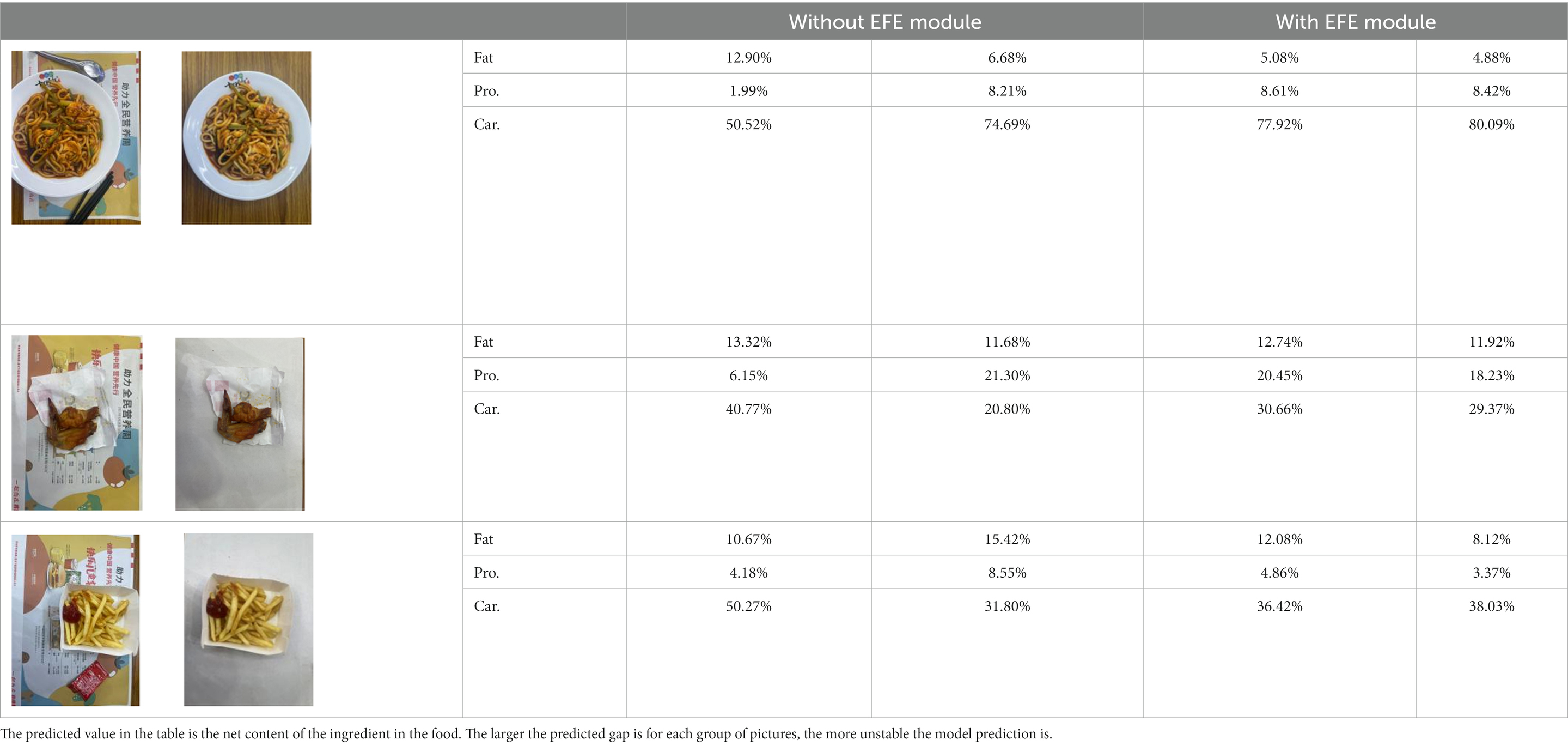
Table 3. The degree of stability of the model predictions for different backgrounds without or with the EFE module.
By increasing the number of decoding layers, we also compared its effect to prove its effectiveness. Table 4 and Supplementary Figure S3 show the model’s predictions for food fats, carbohydrates, and proteins when different numbers of decode layers are added.
4. Conclusion
We designed an innovative neural network architecture DelicacyNet, which included the following four main modules: environment feature extraction module, encoder, decoder, and semantic output module. After inputting food pictures, we analyzed and obtained the main nutrients contained in the raw materials of the food. After receiving the image, our program first extracted the environmental features, then performed special processing on the features through the encoder, and finally output the obtained features in the form of a text table through the decoder. Our model had high accuracy in the process of predicting food components, and can be applied in practice.
At present, our model can help humans understand the content and proportion of nutrients in their daily intake, so as to selectively decide the nutrition and energy intake in food, and help humans rationally match the required diet. Next step, we hope that our program can expand into new fields, for example, the type and content of raw materials of food can be obtained through the program, and the data of major allergens can be combined to help human prevent diseases.
Data availability statement
The original contributions presented in the study are included in the article/Supplementary material, further inquiries can be directed to the corresponding author.
Author contributions
RL: investigation, data curation, and writing-original draft preparation. PJ: methodology, investigation, and writing-original draft preparation. QK: conceptualization, funding acquisition, and writing – review & editing. All authors contributed to the article and approved the submitted version.
Funding
This study was supported by the National Key R&D Program of China (2019YFD0901705).
Conflict of interest
The authors declare that the research was conducted in the absence of any commercial or financial relationships that could be construed as a potential conflict of interest.
Publisher’s note
All claims expressed in this article are solely those of the authors and do not necessarily represent those of their affiliated organizations, or those of the publisher, the editors and the reviewers. Any product that may be evaluated in this article, or claim that may be made by its manufacturer, is not guaranteed or endorsed by the publisher.
Supplementary material
The Supplementary material for this article can be found online at: https://www.frontiersin.org/articles/10.3389/fnut.2023.1247631/full#supplementary-material
References
1. Darmon, N, Darmon, M, Maillot, M, and Drewnowski, A. A nutrient density standard for vegetables and fruits: nutrients per calorie and nutrients per unit cost. J Am Diet Assoc. (2005) 105:1881–7. doi: 10.1016/j.jada.2005.09.005
2. Maillot, M, Darmon, N, Darmon, M, Lafay, L, and Drewnowskis, A. Nutrient-dense food groups have high energy costs: an econometric approach to nutrient profiling. J Nutr. (2007) 137:1815–20. doi: 10.1093/jn/137.7.1815
3. Mostafa, MM. Clustering halal food consumers: a twitter sentiment analysis. Int J Market Res. (2019) 61:320–37. doi: 10.1177/1470785318771451
4. Drewnowski, A, and Fulgoni, VL. New nutrient rich food nutrient density models that include nutrients and myplate food groups. Front Nutr. (2020) 7:107. doi: 10.3389/fnut.2020.00107
5. Kalra, S, Singla, R, Rpsha, R, and Dhawan, M. Ketogenic diet: situational analysis of current nutrition guidelines. J Pak Med Assoc. (2018) 68:1836–9.
6. Hendrie, GA, Rebuli, MA, James-Martin, G, Baird, DL, Bogard, JR, Lawrence, AS, et al. Towards healthier and more sustainable diets in the Australian context: comparison of current diets with the Australian dietary guidelines and the EAT-lancet planetary health diet. BMC Pubilic Health. (2022) 22:1939. doi: 10.1186/s12889-022-14252-z
7. Min, W, Jiang, S, Liu, L, Rui, Y, and Jain, R. A survey on food computing. Acm Csur. (2019) 52:1–36. doi: 10.1145/3329168
8. Bossard, L, Guillaumin, M, and Gool, LV. (2014). Food-101–mining discriminative components with random forests. Computer Vision–ECCV 2014: 13th European Conference, Zurich, Switzerland, September 6–12, 2014, Proceedings, Part VI 13. Springer International Publishing. 446–461.
9. Chen, J, and Ngo, C. (2016). Deep-based ingredient recognition for cooking recipe retrieval. Proceedings of the 24th ACM international conference on Multimedia. 32–41.
10. Lu, Y, Stathopoulou, T, Vasiloglou, MF, Christodoulidis, S, Stanga, Z, and Mougiakakou, S. An artificial intelligence-based system to assess nutrient intake for hospitalised patients. IEEE Trans Multimedia. (2020) 23:1136–47. doi: 10.1109/TMM.2020.2993948
11. Marín, J, Biswas, A, Ofli, F, Hynes, N, Salvador, A, Aytar, Y, et al. Recipe1M: a dataset for learning cross-modal embeddings for cooking recipes and food images. IEEE Trans Pattern Anal Mach Intell. (2021) 43:187–203. doi: 10.1109/TPAMI.2019.2927476
12. Wang, H, Lin, G, Hoi, SC, and Miao, C. (2020). Structure-aware generation network for recipe generation from images. Computer Vision–ECCV 2020: 16th European Conference, Glasgow, UK, August 23–28, 2020, Proceedings, Part XXVII 16. Springer International Publishing. 359–374.
13. Min, W, Wang, Z, Liu, Y, Luo, M, Kang, L, Wei, X, et al. Large scale visual food recognition. IEEE Trans Pattern Anal Mach Intell. (2023) 45:9932–49. doi: 10.1109/TPAMI.2023.3237871
14. Davis, H, Wilde, D, Bertran, FA, and Dolejsova, M. (2020). Fantastic(e)ating food futures: reimaging human food interactions. Companion Publication of the 2020 ACM Designing Interactive Systems Conference. 377–380.
15. Deng, JL, Bertran, FA, Obrist, M, Wang, Y, Mueller, FF, and Velasco, C. Sketching the future of human-food interaction: emerging directions for future practice. Int J Gastron Food Sci. (2022) 31:100629. doi: 10.1016/j.ijgfs.2022.100629
16. Zhang, D, Wang, J, Kosta, K, Smith, JBL, and Zhou, S. Modeling the rhythm from lyrics for melody generation of pop song. arXiv. (2022). doi: 10.48550/arXiv.2301.01361
17. Xu, B, He, L, Liang, J, and Sun, Z. Learning feature recovery transformer for occluded person re-identification. IEEE Trans. Image Process. (2023) 31:4651–62. doi: 10.1109/TIP.2022.3186759
18. Berquin, Y. Bayesian statistical learning using density operators. arXiv. (2022). doi: 10.48550/arXiv.2212.14715
19. Jin, S, Liu, N, and Yu, Y. Quantum simulation of partial differential equations via Schrodingerisation: technical details. arXiv. (2022). doi: 10.48550/arXiv.2212.14703
20. Dong, H, Yao, J, Tang, Y, Yuan, M, Xia, Y, Zhou, J, et al. Improved prognostic prediction of pancreatic Cancer using multi-phase CT by integrating neural distance and texture-aware transformer. arXiv. (2023). doi: 10.48550/arXiv.2308.00507
21. Liu, Z, Mao, H, Wu, C, Feuchtenhofer, C, Trevor, D, and Xie, S. A ConvNet for the 2020s. arXiv. (2022). doi: 10.48550/arXiv.2201.03545
22. Woo, S, Debnath, S, Hu, R, Chen, X, Liu, Z, Kweon, IS, et al. ConvNeXt V2: co-designing and scaling ConvNets with masked autoencoders. arXiv. (2023). doi: 10.48550/arXiv.2301.00808
23. Zhao, W, Rong, S, Ma, J, and He, B. Nonuniform illumination correction for underwater images through a pseudo-siamese network. 2022 26th International Conference on Pattern Recognition (ICPR). IEEE. 1329–1335.
24. Qi, H, and Dong, X. Physics-aware semi-supervised underwater image enhancement. arXiv. (2023). doi: 10.48550/arXiv.2307.11470
25. Geng, M, Meng, X, Yu, J, Zhu, L, Jin, L, Jiang, Z, et al. Content-noise complementary learning for medical image Denoising. IEEE Trans. Med. Imaging. (2022) 41:407–19. doi: 10.1109/TMI.2021.3113365
26. Huang, S, Wang, X, and Tao, D. Stochastic partial swap: enhanced model generalization and interpretability for fine-grained recognition. 2021 IEEE/CVF International Conference on Computer Vision (ICCV). 600–609.
27. Starowicz, M, and Zielinski, H. How Maillard reaction influences sensorial Properies (color, flavor and texture) of food products. Food Rev Int. (2019) 35:707–25. doi: 10.1080/87559129.2019.1600538
28. Murata, M. Browning and pigmentation in food through the Maillard reaction. Glycoconj J. (2020) 38:283–92. doi: 10.1007/s10719-020-09943-x
29. Sun, Y, Al-Zahrani, FAM, and Lin, L. Colour formation of dihydroxyacetone with cysteine and its derivatives via Maillard reaction. Dyes Pigments. (2022) 208:110854. doi: 10.1016/j.dyepig.2022.110854
30. Wang, Y, Liang, B, Ding, M, and Li, J. Dense semantic labeling with atrous spatial pyramid pooling and decoder for high-resolution remote sensing imagery. Remote Sens. (2018) 11:20. doi: 10.3390/rs11010020
31. Vaswani, A, Shazeer, N, Parmar, N, Uszkoreit, J, Jones, L, Gomez, AN, et al. Attention is all you need. Adv Neural Inf Proces Syst. (2017) 30:5998–6008. doi: 10.48550/arXiv.1706.03762
32. Wu, H, Xiao, B, Codella, N, Liu, M, Dai, X, Yuan, L, et al.. (2021). Cvt: introducing convolutions to vision transformers. Proceedings of the IEEE/CVF international conference on computer vision.
33. Travis, F, and Shear, J. Focused attention, open monitoring and automatic self-transcending: categories to organize meditations from Vedic, Buddhist and Chinese traditions. Conscious Cogn. (2010) 19:1110–8. doi: 10.1016/j.concog.2010.01.007
34. Xiao, X, Zhang, D, Hu, G, Jiang, Y, and Xia, S. CNN–MHSA: a convolutional neural network and multi-head self-attention combined approach for detecting phishing websites. Neural Netw. (2020) 125:303–12. doi: 10.1016/j.neunet.2020.02.013
35. Food safety - Food nutrient query table. (2012). Available at: http://www.eshian.com/sat/yyss/list (accessed June 5, 2023).
36. Szegedy, C, Liu, W, Jia, Y, Sermanet, P, Reed, S, Anguelov, D, et al.. (2015). Going deeper with convolutions. Proceedings of the IEEE conference on computer vision and pattern recognition.
37. Simonyan, K, and Zisserman, A. Very deep convolutional networks for large-scale image recognition. arXiv. (2014). doi: 10.48550/arXiv.1409.1556
38. Hu, J, Shen, L, and Sun, G. (2018). Squeeze-and-excitation networks. Proceedings of the IEEE conference on computer vision and pattern recognition.
39. Min, W, Liu, L, Wang, Z, Luo, Z, Wei, X, Wei, X, et al.. (2020). ISIA food-500: a dataset for large-scale food recognition via stacked globallocal attention network. Proceedings of the 28th ACM International Conference on Multimedia. 393–401.
40. Han, D, Yun, S, Heo, B, and Yoo, Y. (2021). Rethinking channel dimensions for efficient model design. Proceedings of the IEEE International Conference on Computer Vision and Pattern Recognition.
41. Vu, X, Le, D, Edlund, C, Jiang, L, and Nguyen, H. D.. (2020). Privacy-preserving visual content tagging using graph transformer networks. Proceedings of the ACM International Conference on Multimedia.
42. Qiu, J, Lo, FP, Sun, Y, Wang, S, and Lo, B. Mining discriminative food regions for accurate food recognition. arXiv. (2022). doi: 10.48550/arXiv.2207.03692
43. Li, Y, Zhang, K, Cao, J, Timofte, R, and Gool, L. Localvit: bringing locality to vision transformers. arXiv. (2021). doi: 10.48550/arXiv.2104.05707
Keywords: recipe, nutrition, computer vision, transformer, environment features
Citation: Li R, Ji P and Kong Q (2023) DelicacyNet for nutritional evaluation of recipes. Front. Nutr. 10:1247631. doi: 10.3389/fnut.2023.1247631
Edited by:
Maria de Fatima Domingues, Khalifa University, United Arab EmiratesReviewed by:
Jovica Jovanovic, University of Niš, SerbiaHao Ran Chi, Institute of Telecommunications (IT), Portugal
Copyright © 2023 Li, Ji and Kong. This is an open-access article distributed under the terms of the Creative Commons Attribution License (CC BY). The use, distribution or reproduction in other forums is permitted, provided the original author(s) and the copyright owner(s) are credited and that the original publication in this journal is cited, in accordance with accepted academic practice. No use, distribution or reproduction is permitted which does not comply with these terms.
*Correspondence: Qing Kong, a29uZ3FpbmdAb3VjLmVkdS5jbg==
†These authors have contributed equally to this work
 Ruijie Li
Ruijie Li Peihan Ji
Peihan Ji Qing Kong
Qing Kong